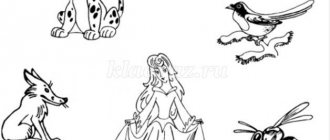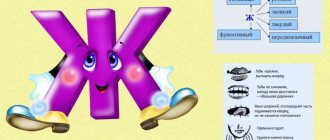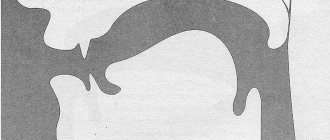Summary of an individual speech therapy lesson on sound production [L]
Goal: setting the sound [L].
Tasks:
1. Correctional and educational: - introduce the sound [L] using the method of gradually creating an articulatory structure; - learn to answer questions accurately and completely; 2. Correctional and developmental: - development of logical thinking, attention, memory; — development of speech motor skills, fine motor skills of the fingers; 3. Educational: - cultivate a friendly attitude towards others, politeness, and a culture of behavior. Equipment: mirror, pictures for articulation gymnastics, toys: mouse, steamer.
Progress of the lesson
1. Organizational moment - Today you and I will learn how to pronounce one very beautiful, magical sound. - Do you like fairy tales? Do you want me to tell you a story about a funny tongue? Then watch and listen.
2. Preparation for sound production [L] - Once upon a time there was a tongue. Meet him. He lived in his own house. Do you know what the house near the tongue is called? (Mouth) He was very curious and often looked out the window. I opened the window, closed it, opened it again, looked out, looked to the right, then looked to the left to see if anyone was coming? Looked up, is the sun shining? I looked down - were there any puddles? Tongue ran to the kitchen, and there mom was kneading the dough. “Let me help you,” said Tongue. Exercise “Kneading the dough.” We kneaded the dough and baked pancakes. Exercise "Pancake". Tongue thanked his mother for the delicious breakfast and ran for a walk. There is a high fence in the yard near the house. Exercise "Fence". Tongue wanted to swing on the swing: up and down! Exercise "Swing". Have fun swinging with Tongue on the swing! Tongue got off the swing and suddenly saw a menacing, angry turkey. The turkey stood in the middle of the yard and cursed terribly. Let's show how Turkey swore. Exercise “Turkey” The tongue got scared and ran home. Suddenly someone knocked. Who's there? It's me, your friend, little mouse. Let `s play. Catch up with me. Exercise “Catch the mouse.” We played catch-up, and now let’s play another game, “Repeat after me.” The speech therapist asks to reproduce a rhythmic pattern. The mouse ran away to his hole. And the tongue got bored, and he went to the clearing. Then he took his favorite toy steamer and began to play with it.
3.Development of breathing. Exercise "Steamboats". (Development of a smooth, long exhalation.) - And now we will turn into steamers. We hit the road. Let's give a farewell whistle. Smile, take a deep breath through your nose, and blow on the wide tip of your tongue - fff, don’t puff out your cheeks.
4. Setting the sound [L] - Lips in a smile, teeth in a fence, the wide tip of the tongue rests on the upper teeth, pronounce the sound [Y] loudly. You get a new sound, say it again and listen to yourself. Today you learned to pronounce a new sound. Say it again.
5. Physical education minute One - squat, two - jump. This is a rabbit exercise. And how do fox cubs wake up (rub their eyes with their fists) They like to stretch for a long time (stretch) Be sure to yawn (yawn while covering your mouth with your palm) Well, wag your tail (move your hips to the sides)
6. Game “The fourth odd one” (working from pictures). Steamboat, boat, plane, sailboat. Car, tram, trolleybus, metro. Airplane, helicopter, bicycle, hot air balloon (as a mode of transport).
7. Development of fine motor skills of the fingers Task: circle the dots and color. - What did you do? Steamboat. - Repetition of articulation.
8. Summary of the lesson - Our fairy tale has come to an end. - Do you like her? - What do you remember? - What sound did you learn to pronounce today?
Summary of an individual speech therapy lesson on the topic: “Producing sound [L]”
Goal: formation of the correct pronunciation of the sound [l] in an isolated position.
Tasks:
- Development of phonemic awareness and phonemic analysis;
- Development of articulatory motor skills, VMF.
- Cultivating perseverance.
Technologies used:
- Health-saving technologies;
- Developmental technologies.
Plan:
I. Organizational moment; II. Subject message; III. Articulation gymnastics; IV. Sound setting [l]; V. Clarification of the articulation of sound [l]; VI. Development of phonemic analysis; VII. Strengthening the connection between the letter and the sound [l]; VIII. Summing up the lesson.
Progress of the lesson
I. Organizational moment
There are several pictures in front of the child (onions, carrots, cabbage). The speech therapist reads the riddle: The grandfather is sitting, dressed in a hundred fur coats, Whoever undresses him sheds tears. - What kind of vegetable is this? Show it in the picture. The child finds a picture of an onion. L.: Yes, this is an onion. What is the first sound in the word onion? R.: Sound [l]. L.: That's how the ship hums. Let's sound the horn and show the ship: the fingers of the hands extended forward are closed at an acute angle, depicting the stern of the ship.
II. Lesson topic message
Today we will learn to hear, find in words and pronounce the sound [l].
III. Development of phonemic processes
L.: I will pronounce the words, and when you hear a word with the sound [l], clap your hands. The speech therapist pronounces the words: lamp, board, cat, bow, shelf. The child claps when he hears the sound [l] in a word. L.: Look at the pictures (the speech therapist names the pictures). Find only those that have the sound [l]. Lamp, squirrel, table, wardrobe, pencil, desk. The child selects the necessary pictures. L.: Let's play the game “Fourth Extra.” The extra words will be those whose names do not have the sound [l]. Spoon, cat, skis, horse; lamp, shelf, board, shovel. The speech therapist pronounces the words and places four pictures in front of the child, the child finds and removes the extra picture. L.: Do you want to ride the train? In front of you is a train with three carriages and pictures (The speech therapist offers the child pictures depicting words with the sound [l] at the beginning, middle and end of the word). Place the words on the cars. If the sound is at the beginning - in the first car, if in the middle - in the middle car (second), if at the end - in the third.
IV. Articulation gymnastics
The exercises “Painter”, “Horse”, “Needle”, “Strongman” are performed.
V. Clarification of sound articulation [l]
L.: Look at the tongue when it pronounces the sound [l]. (The speech therapist shows a picture of the sound profile). Where is the tip of the tongue? R.: tip of tongue at the top. Are your teeth closed or open? R.: Revealed. Are the lateral edges of the tongue pressed against the upper teeth or not? R.: No L.: The tongue is saddle-shaped. (The speech therapist shows a picture with a saddle, the child repeats; you can show a dummy tongue).
VI. Sound setting [l]
The speech therapist uses three methods of setting. 1. (By imitation) L.: Sound like a ship (l-l-l-l-l) 2. (Based on the profile of the tongue and verbal instructions in front of the mirror) L.: Make a needle. Look how sharp the tip of the tongue is. Lift it up and press it against the tubercles (alveoli) (the speech therapist shows the profile). Now sound like a steamboat (make the sound [s]). Do not lower the tip of the tongue. 3. (From the interdental sound [s]) L.: Make a wide tongue, insert it between the teeth, lightly bite the tip of the tongue and pronounce the sound [s] for a long time - you get a hard sound [l]. After the performance, the speech therapist suggests honking like a steamship, then like an airplane, like an elephant.
VII. Summing up the lesson
- What sound did we learn to pronounce? - Sound [l]. — How to pronounce the sound [l]? (The child repeats the articulation of the sound l).
Teacher-speech therapist MBDOU DS combined type No. 3, Smolensk: Rubtsova Maria Aleksandrovna
Also on topic:
Summary of an individual lesson on sound consolidation [L]
Setting the sounds [L] and [L]
1. Setting [l] mechanically. The mechanical method of setting is a common method used in speech therapy practice;
Using a soft [l] as a base sound, ask the child to repeat the syllable [la] several times, then, using a probe, press the middle part of the back of the tongue downwards - to the right or left, and ask the child to pronounce the combination [la] several times. At the moment of pronunciation, adjust the movement of the probe until the acoustic effect of solid [l] is obtained.
2. When replacing the sound [l] with [l'], it is recommended to set [l] from [s], because in this case, the incorrect sound depends on the tension of the tongue in the anterior-middle part, and not in the back;
In cases of failure, the following techniques can be used: mechanical assistance - with two index and ring fingers, apply light pressure on the neck so that each finger hits a point at the inner edge of the posterior third of the left and right branches of the lower jaw. Suggest creating some tension in the area of the shoulder girdle and neck, for which you need to bend your head forward and in this position pull out the sound [l] as low as possible. It is important to pay attention to the kinesthetic sensations that arise from lifting the root of the tongue.
3. When replacing the sound [l] with the sound [j], the child is taught to hold the tip of the tongue behind the teeth, pressing it firmly against the upper teeth, lower the middle part of the back of the tongue, and tuck the back;
In order for the tongue to take this position, the child is asked to insert the tip of the tongue between the front teeth and say drawn out [s] or, with the mouth open, place a round plastic tube on the middle part of the tongue, and lift the tip of the tongue behind the upper incisors.
4. When replacing [l] with [y], first of all, you need to convey to the child that the lips should not move;
To do this, they suggest looking in the mirror at your lips while repeatedly pronouncing the syllable [la]. Then the adult himself pronounces this syllable and draws the child’s attention to the fact that the lips do not stretch forward, the tongue is visible all the time - it descends from top to bottom. The child is told: “Your lips are naughty. You want them not to stretch forward, but they do it their own way. Let's teach them to obey. We command our lips: stretch forward like a tube!” The child easily performs the movement he is familiar with. “Now stretch your lips as if you are smiling (this will not make it difficult for the child either). You see, your lips have become obedient because you told them what they should do.” The exercise is repeated several times until the child learns to easily switch from one movement to another at a fast pace. “Now let’s work with the tongue. Look what my tongue will do” (The speech therapist raises the tongue by the upper teeth, firmly presses its tip, then lowers it, the lips are always in a smiling position). “Do the same.”
5. When replacing [l] with [v], it is necessary to slow down the movements of the lower lip;
To do this, the child is taught to first lower it, exposing the teeth, and hold it in this position for a count of 3 to 5, then lift it to the upper teeth. These movements are repeated several times. If the child does not succeed, use mechanical assistance, then lower and raise the lower lip with the index finger placed under it.
6. When replacing [l] with [g], practice the position of the tip of the tongue, first between the teeth, then at the upper incisors; The child is shown what is wrong with his pronunciation and how it differs from correct articulation. The speech therapist says: “say la, la, la (the child says “ha, ha, ha”). See how far your tongue has gone? Look where I have it. It is pressed against the upper teeth. Do the same. Say [s], but don’t lower your tongue, but hold it behind your teeth like this.”
7. When pronouncing the sound [l] bilabial or labial-dental, it is necessary to slow down the forward movements of the lips, strengthening the grin of the lips;
If the child does not succeed in this, mechanical assistance is used: they fix the lips in a smile, pressing the corners of the lips with their fingers in the first case, and hold the lower lip with the index finger in the second case.
8. With nasal lambdacism, you should pay attention to the air stream coming out of the mouth on the sides of the tongue.
The child is asked to hold the root of the tongue down and the soft palate at the top in front of the mirror (yawning, raising and lowering the back of the tongue, alternately pronouncing with an open mouth: a-n-a-n...). Then, using the traditional technique, the correct sound [l] is placed. At first, the wings of the nose are pinched.
During the work, the speech therapist can use speech therapy probes or other available materials (probe substitutes) suitable for these purposes. But it is important to ensure the sterility of these items.









